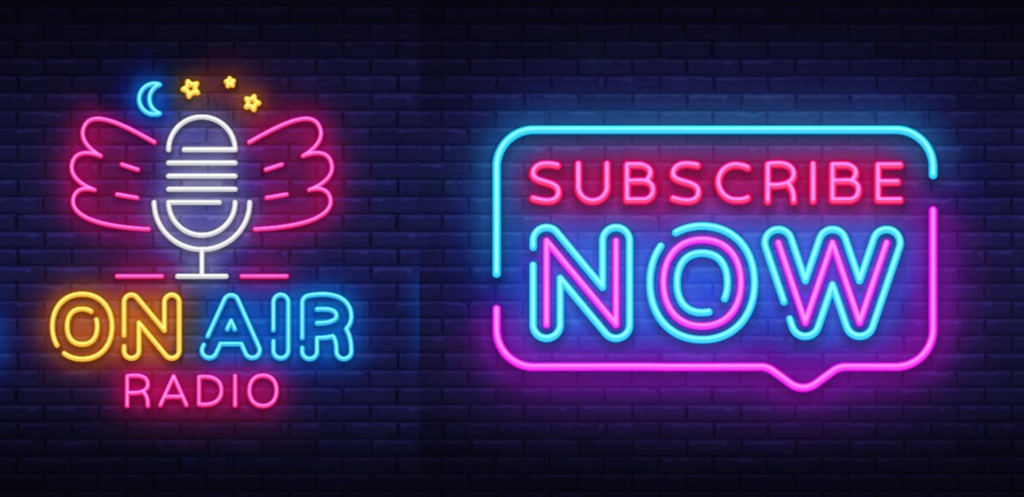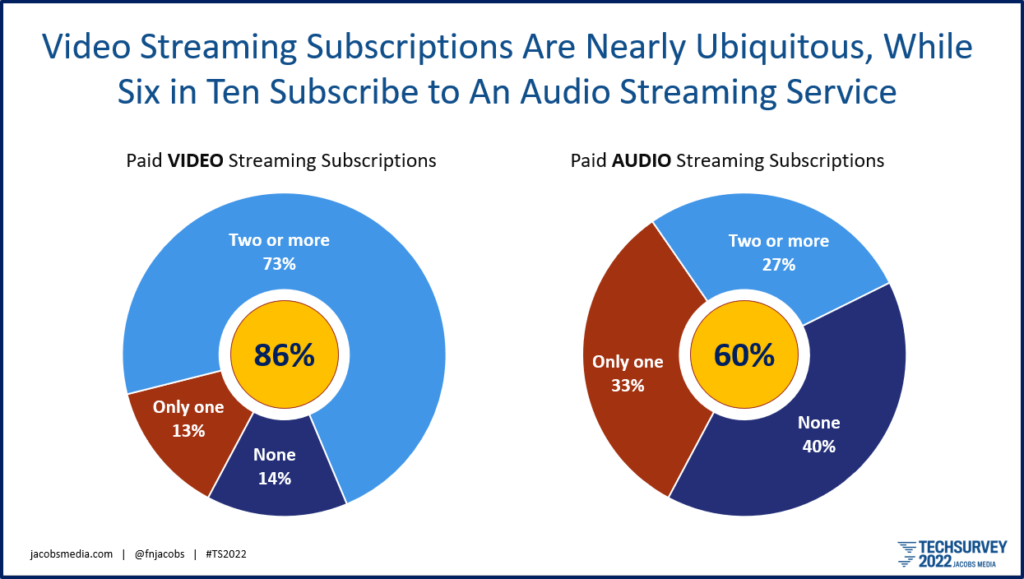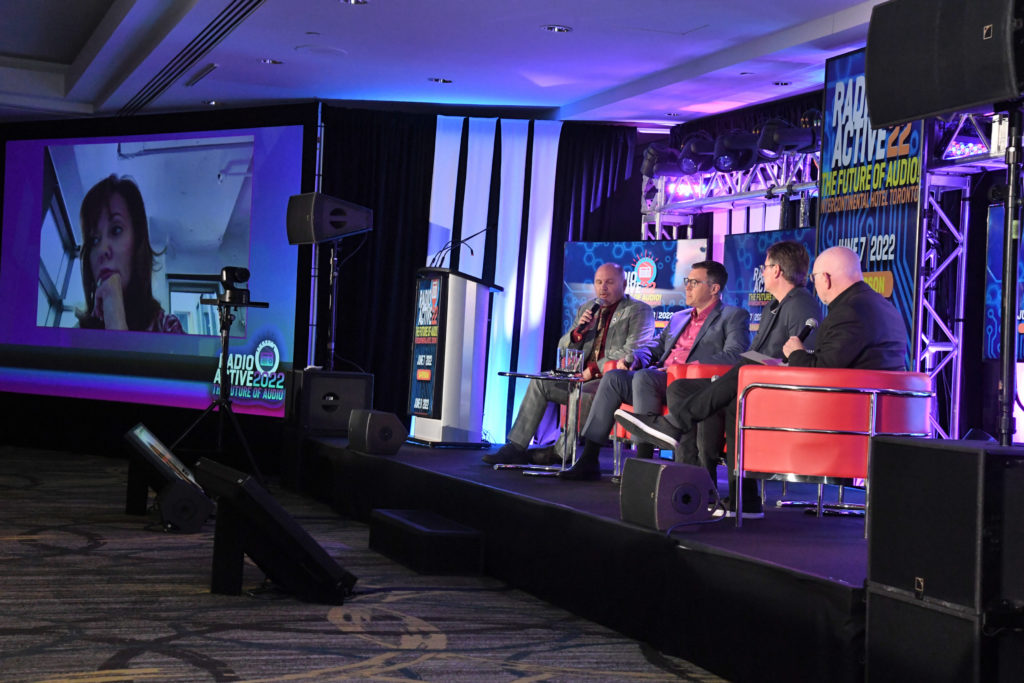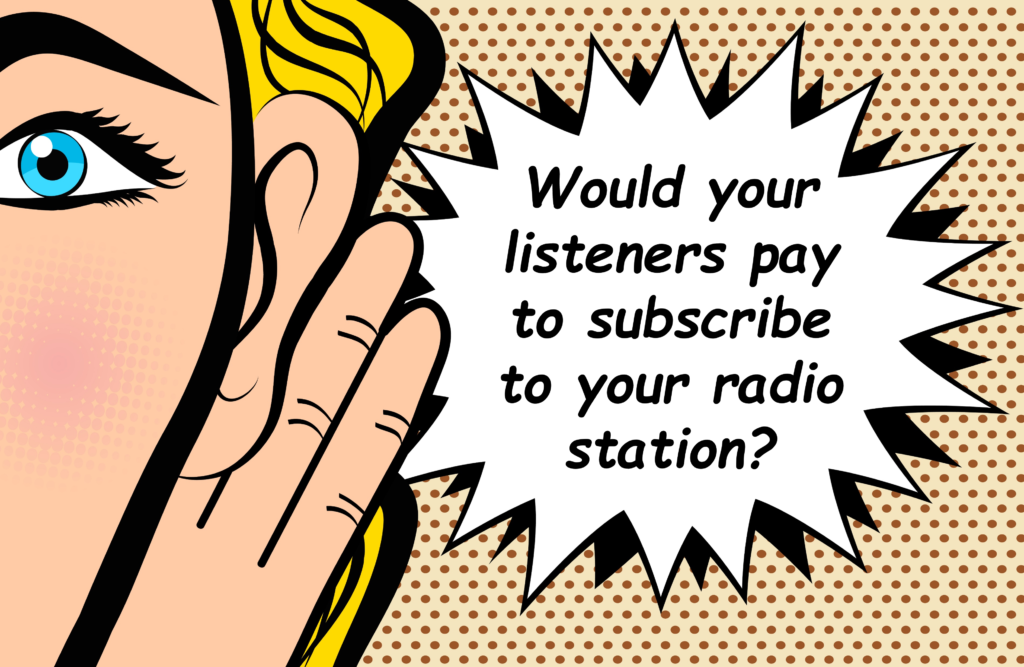
The graphic at the top of this post seems incongruous. We have subscription radio, notably SiriusXM. It was selling monthly subscriptions long before Netflix, Spotify, and other content services. Now subscription audio has become commonplace from Apple, Amazon, Spotify, and myriad other services.
Then there’s public radio, a content-rich platform, supported by millions of fans with their donations. But they’d rather use a “membership” model than a “subscription” one. Public radio functions on the “honor system.” They hope that if you listen, you’ll feel a sense of obligation (and maybe some guilt) to contribute. But whether you’re generous or kind enough to pay your fair share or not, your local public radio station stays on the air.
But commercial radio? The concept of subscribing to your favorite radio station is a foreign concept. That’s just not the way it works. Commercial stations make money with…commercials.
But what if broadcasters adopted similar tactics to all those digital streaming platforms, creating a different experience from the one we’ve become accustomed to for a century? What if they offered an alternative version you could subscribe to in exchange for a better listening experience?
It could be a streaming version of a station, devoid of all those commercials, offering the ability to skip several songs an hour. Could anyone imagine attempting this type of experiment? And even if they did, could it possibly succeed? After all, would radio listeners actually shell out money to access a product they’ve always received for free?
We do know a majority of core radio fans are already paying monthly fees to receive audio content. Our Techsurveys confirm that. In fact, more than six of every ten respondents in this year’s study told us they’re audio subscribers, especially the younger wing of the radio audience. Nearly nine in ten pay a monthly tariff to stream videos on platforms like Netflix, Disney+, and Hulu.

That represents a lot of revenue coming directly out of the pockets, purses, checkbooks, and credit cards of regular radio listeners.
But commercial radio is ad-supported, of course. Oftentimes, too much so. On most U.S. stations, especially in PPM markets, spots are crammed, jammed, and slammed into two stopsets an hour – not a great experience for listeners. In fact, most research indicates commercials – their quality and especially their quantity – are often the biggest turnoff for most stations.
Attempts to radically cut back on commercial inventory have often paid off in ratings. We were involved with KNDD in Seattle when they tried the “2 Minute Promise” experiment a few years ago. Their ratings reached impressive levels, but the sales department was unable to demand premium rates for a much improved commercial environment. When “2MP” ultimately was retired, I became resigned to the reality broadcast radio might never solve its bloated commercial load woes.
But across the pond, there’s a fascinating experiment taking place at Europe’s commercial radio company, Bauer Media. They’re headquartered in the UK, also owning stations in Sweden, Norway, Denmark, Finland, Poland, Portugal, Ireland, and Slovakia with a reach of 60 million.

And as of one year ago, they’ve launched a bold premium subscription service with a number of their best radio brands – and more are on the way.
Last week in Toronto at the reborn Canadian Music Week conference, I was honored to moderate a panel of top executives from around the globe: Corus Entertainment’s Troy Reeb, Pattison Media’s Rod Schween, Caroline Beasley who you know well from Beasley Media Group, and Tobias Nielsen from Bauer.
Titled “From Traditional to Digital: A Management Challenge Summit,” it turned out to be a great conversation among passionate, forthright executives who leveled with the audience about radio’s challenges and opportunities.
Tobias led off with a keynote describing Bauer’s initiative, up and running since May 2021, and now expanding at other European properties. These premium radio stations are, of course, commercial-free. And they include up to six song skips an hour.
The monthly fee? €3.99 – or about $5 U.S. per station. Tobias reports that retention is north of 70%, an excellent sign for the efficacy of this model. Bauer also gets the side benefit of metrics on these “premium” offerings, allowing its programming team to study skips and other usage patterns stations don’t get with traditional ratings. For Bauer, this data has been eye-opening.
So, is there a “there there?”

All three North American CEOs came away impressed with Bauer’s initiative. There are concerns, however, about its viability in their radio environments, given the unique circumstances common to countries and companies. This includes scale and reach issues, especially in Canada, where the CRTC – Canada’s equivalent of the FCC – has been far less open to deregulation. There are also content concerns, as well.
These CEOs are looking at many different solutions to grow and diversify their services, and of course, their revenue. Tobias referenced Bauer’s recent purchase of Communicorp, a media company in Ireland, as a sign there will be more radio growth across Europe for his company. For Corus, Pattison, and Beasley, all three are looking at their radio assets being a key part of expanding their media information and entertainment enterprises.
For Caroline Beasley, it’s been about bolstering the company digital infrastructure and assets, as well as its investment in e-sports. Like Beasley, Pattison and Corus are focusing on their content plays, gravitating away from “radio” as their sole source of revenue. Digital agencies, podcasting, and other digital products are providing marketing diversity for advertisers. Mergers and acquisitions are priorities for all these executives.
I’ve moderated a number of these sessions in the past, at events as diverse as Radio Ink’s Forecast to a radio panel for FCC staffers in late 2019. This CMW session stood out for its candor, and its executives distinguished themselves with their honesty and willingness to talk to each other, compare notes, and explore topics that might not have even been on the table just a few short years ago.

And that brings us back to Bauer. After Tobias’ presented on his company’s “premium” subscription offerings, I asked the audience “Would your radio station be successful with this subscription model? Would your audience fork over their hard-earned cash to pay for a better version of what you’re broadcasting for free now?”
Bauer believes in this plan because they’re put in the research and development so necessary for a venture of this scale – and risk. Tobias Nielsen walks the walk. Well after he had worked in radio for years, he pivoted and got an MBA to ensure his future forays into new technologies and platforms would achieve optimal success. Tobias directed some of his degree requirements into studies of subscription viability in a broadcasting world. We talked about the value of a great education in yesterday’s post. Tobias Bauer is the poster boy for going back to school and getting that degree.
So, let me ask you the same question I asked our attendees in Toronto last week:
Would your listeners pay to subscribe to your station?
And if the answer is “no,” what would you need to change about your station in order to make it “premium ready?”
Interestingly, Tobias revealed the demographic profiles for the “premium” versions of his over-the-air stations are very similar. People are simply paying for an improved version of these brands.
Aside from making them commercial-free and (in the case of music stations) providing songs skips, wouldn’t it make sense to staff up around the clock with live (or live-sounding) talent? Or a higher level of marketing and branding? What about contests designed to capture imagination, and not just diaries and meters? And how about an improved and possibly expanded music library? After all, the song skip research would likely prove to be more valuable than any music testing a station invests in.
 Then there’s the idea of stations being in the moment, capturing the vibe of their market. And production that is fun, tongue in cheek, bigger than life – or all of the above. And let’s not forget connecting with the audience, paying or not, at local events or on social media channels. These are all attributes that might contribute to the idea of listeners actually contributing to the bottom line.
Then there’s the idea of stations being in the moment, capturing the vibe of their market. And production that is fun, tongue in cheek, bigger than life – or all of the above. And let’s not forget connecting with the audience, paying or not, at local events or on social media channels. These are all attributes that might contribute to the idea of listeners actually contributing to the bottom line.
The possibilities are intriguing to say the least. Eyes and ears will be on Bauer’s “premium” program – and how it performs financially. In our “subscription economy,” should commercial radio explore ways to cash in?
And what about public radio stations? Is there a way to convert “membership” to “subscribership,” and how might that affect the medium’s financial health and long-term sustainability?
Canadian Music Week got the ball rolling last week.
Could your station pass the “subscription test?”
Thanks to Neill Dixon, Danya Dixon, and Ross Davies for the opportunity to moderate this great panel. Thanks again to Caroline, Rod, Tobias, and Troy for providing a thoughtful, informed discussion. – FJ
- Media And Technology In 2025: Believe It Or Not! - April 18, 2025
- In Radio, You Just Never Know - April 17, 2025
- The Secret To Making A Great Podcast (And Great Radio) - April 16, 2025




There might be another Bauer radio property to keep an eye on–although this one is something that it inherited when it recently bought that national group in Portugal (and which I coincidentally just stumbled across). In addition to the main formats (including the CHR brand Cidade FM), there’s a specialty format that uses Vodafone’s name–and heavily promotes online upvoting/downvoting of songs, to the point where the website’s structure focuses on that and is completely different from those of the main formats. (Unlike those other formats, Vodafone FM’s site isn’t housed on the IOL portal.)
Vodafone FM apparently has been around for about a decade, but might’ve recently shifted its music mix (per its Wikipedia entry, at https://pt.wikipedia.org/wiki/Vodafone_FM). Also, since it’s inconspicuous on the website, here’s a raw Google translation of the basic About language…
What makes Vodafone FM move
We started our project with the certainty that the greatest specialists in Music are those who make it and those who listen to it. From this certainty Vodafone FM was born, because we feel and understand that if Music moves you, then you should be able to move Music.
Our mission is heard in our broadcast when we bring all the best and most relevant of new music made in Portugal and in the rest of the world to all attentive ears. Our radio grows with the power of sharing, and this can be seen on our website, where through the Like/Dislike button each of our listeners can express their opinion and influence our playlist.
We work every day to be a radio open to what is new and to the opinion of our listeners. And to be that radio, we have to leave the studio and come out into the street. Only in this way can we be close to the new Music, to those who make it and those who listen to it. Our presence at music events or events related to it will always be in order to reduce the distance between music and those who cannot live without it.
These are the ideas that move us and if you share them with us, then this radio is also yours.
Mix in Music.
You knew I’d jump into this one, Fred.
And you said it yourself: Sirius/XM has been in the “premium” orbit (sorry) for years. Both SXM and terrestrial radio are direct point-to-multipoint, so why has SXM alone figured out conditional access and made it financially viable? The window of opportunity to incorporate this technology into HD Radio for terrestrial broadcasting may have passed, still it’s a question worth asking.
But, from your description, Bauer hasn’t done this–they aren’t broadcasting ad-free content over the air, they’re exporting it ad-free digitally, ie, over the internet; just like thousands of other internet-only “radio stations,” some of them excellent and very stiff competition (eg, Radio Paradise) (cf. public and community radio stations also streaming local content ad-free, like KQED, WERU, WBCM et al).
If local OTA radio broadcasters want to compete with these, relying on their inherent strength in localism, they definitely have their work cut out. I’d love to see (hear) them try. I probably would add one or two good ones to the dozen of audio streams I already subscribe and pay for every month.
Of course, what I’d really like to hear is their ad-free content coming to me OTA without the internet shackle. I’d pay for that in a heartbeat.
John, thanks for weighing in. And your point that OTA is the Holy Grail of this “experiment” is well taken. Knowing Tobias, if his research shows Bauer can make more money (via subs, of course) with an over the air product, they will do it. For now, I think they like having two different revenue streams for (essentially) the same proudct.
There has to be a lot of head scratching when you pay for a program service and they still load up on commercial breaks. The question that has to be answered is “What am I paying for?”
Your program content has to be something the listener needs, enjoys or makes listener life more enjoyable. “Why should I listen?” But isn’t that true for all commercial media?
(I say all this after running a group of cable access channels that mostly ran paid infotainment that was subscription based.)
In the case of Bauer (and I would suspect for most if not all commercial broadcasters) there are no commercials. As you point out, that’s a big part of why you pay a subscription fee.
Many of the OTA AM stations I listen to, Chicago’s WGN, WSCR, WBBM; Milwaukee’s WTMJ are overloaded with commercials. But it appears their content is good enough to hold on to listeners. Doubt they’d drop the status quo.
Having spent 30+ years selling radio (pre-Covid) in Wisconsin, for some fine AM content stations (including farm programs), competition made rate hikes challenging. Some Mid-West Family advantages: live, local, community active and giving, plus mature PDs, talent and salespeople made our sales jobs easier. I enjoyed every minute (and half minute) of it!
Leo, AM stations have been trashed with commercials and paid programming, both of which make for a sub-optimal experience. And yes, kudos to Mid-West Family, consistently committed to their communities.